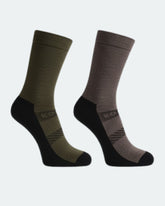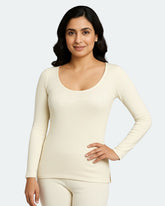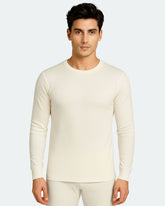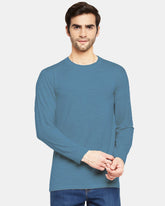Cotton vs Wool for Winter: Which Keeps You Warmer?
When it's cold outside and you bang it on the door, your skin is devoured by it and the first thought is, ‘am I warm enough’. Your material selection is the key. For most of us, that choice often comes down to two classics cotton and wool.
The discussion of cotton vs wool for winter has been around for generations. Cotton is soft, breathable, and comfortable; while wool is warm, insulated, and trusted. But when it really gets cold, which of the fabrics is better? Let's take a look to investigate what each fabric is good for.

Cotton thermals offer comfort and breathability, but wool is warmer than cotton and better at retaining body heat in winter.
Table of Contents
-
Introduction
-
Cotton: Easy but Limited
-
Wool: Built for the Cold
-
Cotton vs Wool for Winter: The Main Differences
-
Where Cotton Fits into Winter Wear
-
Why Wool Is the Outdoor Champion
-
Real-Life Situations
-
Making Your Choice
-
Conclusion
-
FAQs
Cotton: Easy but Limited
Cotton has been worn for centuries and is a part of our existence. It’s the blanket you reach for when you seek comfort. Soft shirts, easy joggers, or light sweaters — cotton feels good against the skin. But when we think about its use in the winter, it gets tricky.
-
Absorbs moisture quickly: Cotton’s a sponge. It soaks up sweat and even small amounts of rain but holds on to it. Once damp, it feels cold against your skin.
-
Insulation issues: When dry, it can provide some warmth. But immediately when cotton is wet, it loses all its ability to keep you warm.
-
Best for indoors: Cotton is at its greatest when you are lounging in your home, travelling in moderate climate weather, or layered underneath other warm fabrics.
Imagine this: arriving home from a long, frozen expedition, and slipping into the Men’s Organic Cotton Comfy Jogger. It won’t trap heat like wool will, but it’s ideal for loungy nights, cuddling you warm without feeling too toasty. So cotton’s cozy and airy but it’s not the earth’s best cold weather Armor All.

Merino wool is the warmest fabric for winter wear, with superior thermal insulation compared to cotton—ideal for layering in extreme cold.
Wool: Built for the Cold
If cotton is comfort, wool is protection. Wool has been a mainstay of cold climes for centuries, and justly so. It’s naturally designed to keep warmth close.
-
Traps heat efficiently: Wool fibers have crimped fibers that create tiny pockets of air. Basically, because of its structure, wool holds warmth around your body in those pockets and, again, this is why wool is often said that it is the best fabric to keep heat from escaping your body.
-
Works then wet: Wool can eat up water (as much as 30% its weight) and still feel warm
-
Toughness: Wool bounces back into shape, resists wrinkles and, with proper care, can last a lifetime.
-
Soft, comfortable options: Merino wool has modernized incredibly so that it's light and itchless, so people can wear it every day.A great example is the Men's Full Sleeves Thermal, made for winter layering versatility.
If you're wondering, is wool warmer than cotton? The answer is a strong yes, since wool can manage heat as well as liquid making it work best in real life winter conditions.
Cotton vs Wool for Winter: The Main Differences
When thinking about cotton vs wool for winter, there’s only really one question that has merit: which fabric keeps you warmer? The truth is in their insulation. Wool wins hands down in the thermal insulation wool vs cotton debate.
-
Wool insulates even if damp.
-
Cotton loses warmth fast once wet.
-
Wool suits unpredictable outdoor weather.
-
Cotton works best indoors or in mild cold.
This is why wool is often dubbed the warmest fabric for winter wear. Cotton has a nice hand feel, warmth aside, there are circumstances when it can’t compete with wool.

Layering wool or synthetic thermals in snowy environments boosts warmth—clearly showing why wool is warmer than cotton for winter treks.
Where Cotton Fits into Winter Wear
It’s not to say that cotton alone isn’t worthy of note. Cotton might not be the warmest fabric for winter wear, but it can’t be completely dismissed out of hand:
-
Home comfort: Perfect for evenings spent indoors. The Women's Cotton Loop Knit Comfy Jogger has a hand feel you want to curl up with a book in.
-
Mild winters: If you live in a fairly moderate climate with, say, a daytime winter temperature rarely dropping below 10-12°C, cotton joggers, sweatshirts, and a light layer are adequate.
-
Layering partner: Pair cotton with wool. A wool base layer with a cotton hoodie combines warmth enough for comfort.
Cotton may make insulation the weaker competitor, but it makes everyday comfort the ultimate winner.
Why Wool Is the Outdoor Champion
When you’re facing unpredictable weather, wool is the safer bet. The thermal insulation wool vs cotton advantage is impossible to ignore.
-
Superior heat retention: Wool is the best fabric to retain body heat on long commutes, hikes, or snowy trips.
-
Performs in varied conditions: Cold winds, drizzle, or sweat — wool adapts.
-
Light but warm: Unlike heavy cotton, wool thermals are lightweight yet cozy.
That’s one reason Kosha chooses Merino wool for many of its layering pieces. It’s reliable, practical, and built for cold-weather travel.
And again, if you’re still asking, is wool warmer than cotton?, the answer isn’t just yes — it’s that wool stays consistently warm in situations where cotton simply gives up.
Real-Life Situations
Picture this:
-
Outdoor commute at 7°C: Cotton joggers may feel fine when you step out, but within minutes, the cold seeps in. Wool thermals underneath a jacket, on the other hand, hold warmth steady until you reach your destination.
-
Relaxing indoors: At home, with a hot drink and a blanket, cotton joggers win for comfort. Wool might feel too warm here.
The conclusion? Each fabric shines in different situations. Wool secures warmth when the weather is unforgiving. Cotton supports relaxation and breathability indoors.
Making Your Choice
In the cotton vs wool for winter debate, your lifestyle matters.
-
For mild winters: Cotton joggers and hoodies are enough.
-
For outdoor or harsh conditions: Wool thermals, sweaters, and layers are essential.
-
For a smart combination: cotton for comfort vs wool for insulation.
If heat is your objective, wool is the toastiest winter fabric. But if comfort is your top priority, then cotton still deserves a home in your closet. Flanking both guarantees you’re geared up for whatever.

Wool's natural fibers trap heat effectively, making it one of the best fabrics to retain body heat—a top choice in the cotton vs wool for winter debate.
Conclusion
So, is wool warmer than cotton? Absolutely. Wool is meant to hold warmth and be dependable, even when wet or windy. Cotton, though, does its thing too — keeping you cozy under the covers or in light weather.
The debate of cotton vs wool for winter isn’t about picking a single winner. It’s about balance. Wool provides the insulation — the best fabric to retain body heat in the thermal insulation wool vs cotton discussion. Cotton brings comfort for downtime and layering.
A smart winter wardrobe blends both. Think of a wool base layer like the Men’s Full Sleeves Thermal, paired with cotton joggers for home comfort. With this mix, you’re ready to face the cold outside and still enjoy ease indoors.
Stay warm. Travel light
Unsure what winter wear to pack for your next cold-weather destination? Wondering if you’ll stay warm enough throughout your trip? Our Winter Layering Expert at Kosha can help you with a light‑but‑mighty winter wear travel kit for your next trip.
We guide you with the layers to carry, based on your chosen destination, the temperature, weather conditions, and the activities on your itinerary. Then, we’ll help you understand exactly what to wear and exactly what to pack - for anything from +15 °C beach breezes to −30 °C Arctic blasts. With light-as-air Merino-Bamboo base layers and jackets, you carry just enough winter gear - yet feel infinitely warmer.
For frequent travellers, who would rather buy and keep thoughtfully made winter wear for the years to come. Seldom or first-time travellers, we’ve got you covered with rental winter wear that you can hire just for your travel dates and return, hassle-free. Book a 1-on-1 video consult call with Kosha’s Winter Layering Expert now.Chat with a Winter Layering Expert
FAQs
1. Which fabric represents the better choice for winter. Cotton vs wool?
In thinking of winter cotton vs wool fabric, wool is the better option for warmth and outdoor use. Cotton is soft and breathable, but the issue is it does not hold warmth when wet, while wool holds warmth conveniently.
2. Is wool warmer than cotton in real winter conditions?
Yes the answer is yes wool is warmer than cotton. Wool's crimped fibers create air pockets, is naturally insulating material. Cotton loses heat fast, and is therefore not a contender for wool in real cold winter.
3. In the thermal insulation wool vs cotton debate, which fabric is the warmest fabric for winter wear?
In the thermal insulation wool vs cotton debate, wool will win, hands down, wool is the warmest fabric for winter wearing options, while cotton is only suitable for light winters, home comfort, or an option for layering.

Christ Keivom
Christ Keivom believes in appreciating the simplicity of things like long walks in quiet early morning or getting lost in a song past midnight.
Editor’s Picks
Alaskan Parka Plus Size Jacket For Women
- From ₹10,125.00
₹13,500.00- From ₹10,125.00
- Unit price
- / per
Woolmark Full Sleeves High Neck Thermal Top For Women
- From ₹1,890.00
₹1,890.00- From ₹1,890.00
- Unit price
- / per
Men's Pack Of 2 Merino Wool Cushioned Technical Socks
- ₹2,148.00
₹3,580.00- ₹2,148.00
- Unit price
- / per
Woolmark Full Sleeves Thermal Top For Women
- From ₹1,255.00
- From ₹1,255.00
- Unit price
- / per
Woolmark Full Sleeves Thermal Top For Men
- From ₹1,890.00
- From ₹1,890.00
- Unit price
- / per













